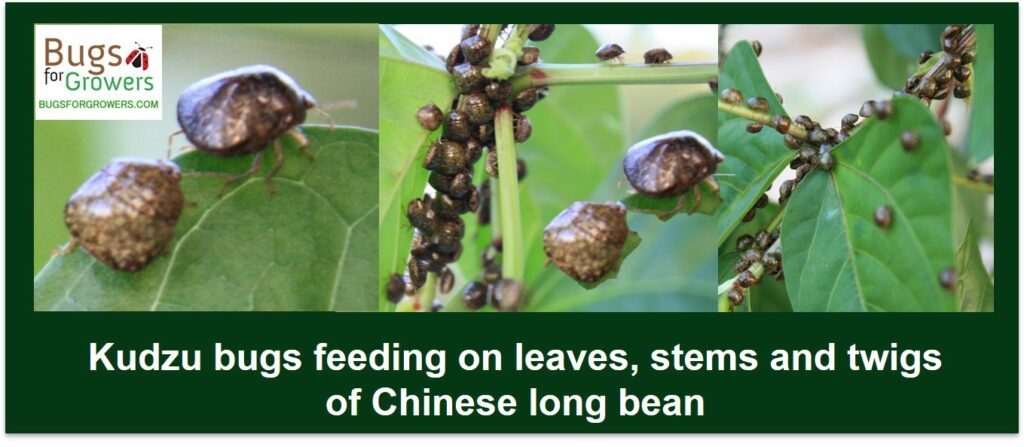Kudzu Bug
The Kudzu bug, Megacopta cribraria, is a globular stink bug first reported in Georgia, USA in 2009 as a serious pest of many legume crops (Photo 1). These bugs since been distributed in various Southern states in the US. Adult Kudzu bugs measure 4 to 6 mm, featuring flattened square bodies with a characteristic head shape. Kudzu bugs are olive-green in color with brown speckles throughout their bodies (Photo 1). Similar to stink bugs, they possess piercing and sucking mouthparts, emitting an unpleasant defensive odor when disturbed.
Photo 1. Kudzu bug adults feeding on Chinese long bean plant
Biology of Kudzu Bug
The Kudzu bug undergoes three developmental life stages: adults, eggs, and nymphs. Adult kudzu bugs generally overwinter in permanent structures such as houses and commercial buildings. As temperatures rises in spring, adults migrate back from buildings to Kudzu vines and other crops like soybeans, black-eyed beans, Chinese long beans etc. (Photo 2).
Photo 2. Chinese long bean plant is infested with Kudzu bugs.
During feeding, mated females lay egg masses in side-by-side rows on leaves. Simultaneously they place endosymbiotic bacteria capsules beneath the eggs. Hatched nymphs consume the symbiotic bacteria, eventually transferring it to the adult stage. Nymphs, appearing hairy and in colors ranging from light orange to olive green or brown. They reach adulthood within 6-8 weeks, completing several generations annually.
Damage Caused by Kudzu Bug
Kudzu bugs cause both direct and indirect damage on legume crops like soybeans, black-eyed beans, and Chinese long beans. Direct damage involves adults and nymphs sucking cell sap from leaves, succulent twigs, stems, flower buds, and green pods. This leads to nutrient and moisture loss, weak plant growth and reduced crop yields. Reports indicate over 20% yield loss in soybeans due to Kudzu bugs.
Indirect damage results from the sticky honeydew secreted by Kudzu bugs, promoting black sooty mold growth on leaf surfaces. This mold can cover entire leaves, hindering photosynthesis. This in turn can reduce the plant’s ability to produce food, ultimately leading to poor plant growth and yield loss.


